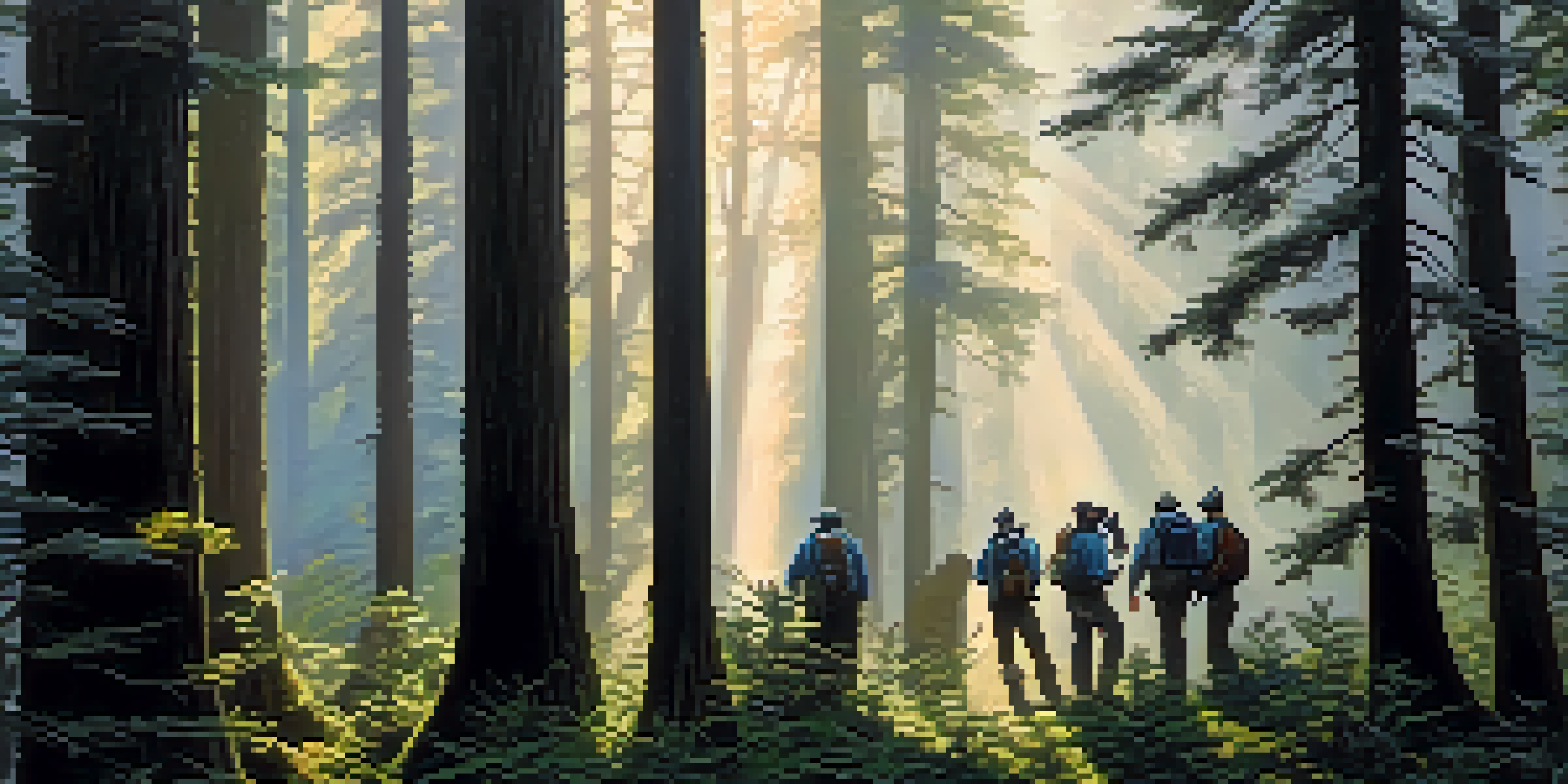Bigfoot Sightings: Legends that Fuel Adventure Tourism

The Allure of Bigfoot: A Cultural Phenomenon
Bigfoot, or Sasquatch, is more than just a creature of folklore; it's a cultural phenomenon that captivates people's imaginations. Stories of a large, hairy humanoid roaming the forests have persisted for centuries, evolving through various cultures and regions. This myth taps into our innate desire for adventure and the unknown, prompting many to seek out their own encounters with the elusive beast.
The search for Bigfoot is not just about finding the creature; it's about the adventure and the stories we create along the way.
The legend has inspired countless documentaries, books, and even movies, solidifying its place in popular culture. From the Pacific Northwest to the Appalachian Mountains, sightings and tales abound, each adding to the mystique surrounding Bigfoot. These stories not only entertain but also encourage people to explore the great outdoors, fostering a sense of adventure.
As more enthusiasts embark on quests to find Bigfoot, the creature's legend continues to grow. Local communities often embrace these tales, turning them into tourist attractions. This blend of folklore and tourism creates a unique opportunity for adventure seekers looking to experience something extraordinary.
Adventure Tourism: A Thriving Industry
Adventure tourism is a booming industry, and legends like Bigfoot play a significant role in its growth. As travelers seek unique experiences beyond traditional sightseeing, they are drawn to activities that provide a thrill and a story to tell. Exploring the forests in search of Bigfoot is not just about the creature; it’s about the journey and the connections made along the way.

Destinations known for Bigfoot sightings, such as the Oregon wilderness or the forests of Washington, have capitalized on this fascination. Local businesses thrive by offering guided tours, merchandise, and themed events that attract both believers and skeptics alike. This influx of tourism can significantly boost local economies, providing jobs and promoting conservation efforts.
Bigfoot Drives Adventure Tourism
The allure of Bigfoot fuels the adventure tourism industry, attracting travelers seeking unique experiences and boosting local economies.
Moreover, adventure tourism often encourages sustainable practices. As more people venture into nature to search for Bigfoot, there is a growing awareness of the need to protect these habitats. This connection between legend and environmental stewardship is a win-win for both adventurers and the ecosystems they explore.
Famous Bigfoot Sightings: The Stories Behind the Legends
Throughout history, numerous sightings have been reported, each adding a layer to the Bigfoot legend. One of the most famous is the Patterson-Gimlin film from 1967, which allegedly captured Bigfoot walking through a California forest. This grainy footage has fueled debates for decades, with some claiming it's irrefutable evidence of the creature, while others dismiss it as a hoax.
Skepticism is the first step toward truth. It's essential to question what we believe and seek evidence in the stories we share.
Another notable sighting occurred in 2008 when a group of hikers in Pennsylvania reported seeing a large, hairy figure moving swiftly between the trees. The excitement surrounding these encounters often leads to increased tourism, as intrigued visitors flock to the sites hoping to catch a glimpse of the legendary creature themselves. Each story adds to a growing tapestry of encounters that enthusiasts love to share.
These narratives not only keep the legend alive but also create a sense of community among believers. Annual Bigfoot festivals and conventions celebrate these tales, drawing in fans from around the world. They come together to share their experiences and theories, making the pursuit of Bigfoot a shared adventure.
Local Communities: Embracing the Bigfoot Legend
For many small towns, the Bigfoot legend has become a cornerstone of their identity. Communities embrace the fascination with festivals, merchandise, and guided tours, turning local lore into a thriving tourism sector. These events often foster a sense of pride and camaraderie among residents, as they share their unique connection to the legendary creature.
Take Bluff Creek, California, for example, which has transformed into a pilgrimage site for Bigfoot enthusiasts. The town hosts annual festivals celebrating the creature, complete with activities, guest speakers, and even reenactments of famous sightings. This has not only boosted local businesses but also created a vibrant community atmosphere that attracts visitors year after year.
Technology Enhances Bigfoot Research
Advancements in technology, from audio recorders to social media, are transforming how enthusiasts pursue Bigfoot, making the quest more accessible.
Moreover, these towns often use the Bigfoot legend to promote conservation efforts. By highlighting the natural beauty of their surroundings, they encourage visitors to appreciate and protect these environments. This synergy between community identity and tourism creates a sustainable model that benefits both residents and nature.
The Role of Technology in Bigfoot Research
In the digital age, technology plays an essential role in Bigfoot research and the pursuit of its legend. From high-tech cameras to drones, enthusiasts are leveraging the latest advancements to capture evidence of the elusive creature. Social media platforms also serve as a hub for sharing sightings, theories, and discussions, bringing together a global community of Bigfoot hunters.
Many researchers are now using audio recording devices to capture potential Bigfoot calls, which have intrigued both skeptics and believers. This innovative approach not only adds credibility to the search but also invites a new generation of adventurers to join the hunt. Technology has transformed how we perceive these legends, making the quest for Bigfoot more accessible and engaging.
However, the reliance on technology also raises questions about authenticity and the nature of evidence. While some argue that gadgets can enhance research, others believe the true spirit of the adventure lies in the personal experience of the search. This ongoing debate is part of what keeps the Bigfoot legend alive and evolving, inviting new perspectives and conversations.
Skepticism: A Necessary Counterpoint
While many are captivated by the idea of Bigfoot, skepticism plays an essential role in the narrative. Skeptics question the validity of sightings and the evidence presented, urging a more critical examination of the claims. This healthy skepticism can foster a more balanced conversation about the legend, encouraging both believers and non-believers to engage in thoughtful discussions.
Moreover, skepticism can lead to more robust research practices. By challenging existing beliefs, researchers are pushed to improve their methods and provide clearer evidence. This critical approach not only benefits the search for Bigfoot but also enhances the overall understanding of folklore and myth-making in culture.
Skepticism Enriches the Legend
Healthy skepticism encourages critical examination of Bigfoot evidence, fostering deeper discussions and enhancing the understanding of folklore.
Ultimately, skepticism adds depth to the legend, reminding us that adventure is not just about the thrill of the chase but also about questioning and understanding the world around us. It encourages individuals to seek out the truth, whether that lies in the existence of Bigfoot or the stories that enrich our lives.
The Future of Bigfoot Tourism: Trends to Watch
The future of Bigfoot tourism looks promising, with trends indicating growth in adventure travel and experiential tourism. As more people seek unique experiences, the quest for Bigfoot offers just that—a chance to explore the unknown while connecting with nature and history. This trend is likely to continue, drawing in both seasoned adventurers and curious newcomers.
Sustainability is also becoming a crucial aspect of tourism. As communities capitalize on Bigfoot legends, there is a growing emphasis on protecting natural habitats and promoting eco-friendly practices. This trend not only preserves the environment but also enhances the overall visitor experience, making it more meaningful and memorable.

In addition, the rise of virtual reality and immersive experiences may shape the future of Bigfoot tourism. As technology continues to evolve, it could offer new ways for people to engage with the legend, whether through virtual tours or interactive storytelling. The possibilities are endless, ensuring that the legend of Bigfoot will remain an exciting adventure for generations to come.